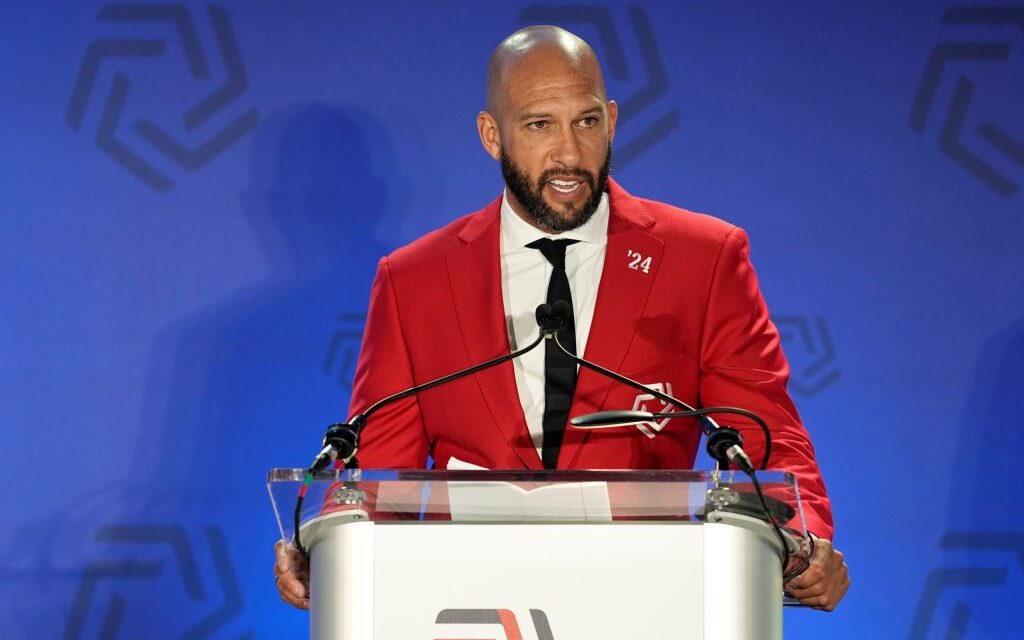By Tracey Reavis
Special to the AFRO
FRISCO, TEXAS – For nearly a quarter of a century, Tim Howard proudly wore his red, white and blue jersey emblazoned with the U.S. crest across the front and No. 1 across the back. His first start for the U.S. men’s national team was in 2002, and Howard says it is right up there as one of his most memorable career moments.
“Without question, that first day in Birmingham, Alabama, at Legion Field, pulling on the national team shirt and walking across the line for my first cap,” Howard said. “Playing for my country, at three World Cups, and being a part of three World Cup teams. Any little kid will tell you, that’s the most special thing you could possibly do is play for your country.”

That little kid’s dream led to an award-winning 21-year career for club and country, and a career-defining honor for arguably the greatest goalkeeper in U.S. men’s national team history.
Tim Howard was inducted into the National Soccer Hall of Fame on May 4. Howard, 44, was elected in his first year of eligibility.
At the induction ceremony, Howard was presented his Hall of Fame red jacket by Chris Sharpe, Colorado Rapids goalkeepers coach with whom he formed a great relationship while playing for the Major League Soccer (MLS) team.
“I often think about what it is I most want people to know about me. I hear people talk about me all the time, and they say, ‘God-given ability.’ I don’t know what that is. That’s ambiguous. It’s vague and it’s subjective. What’s not ambiguous and vague and subjective was my desire to be the greatest goalkeeper this country has ever seen,” Howard stated in his acceptance speech.
Howard’s career is most definitely Hall of Fame worthy. The New Jersey native played 21 years for Major League Soccer and the English Premier League, and holds the record for the most caps, 121, for a U.S. goalkeeper.
Howard’s soccer journey began when he joined the Olympic Development Program at 13. He eventually played in the 1999 FIFA World Youth Championship with the U.S. U-20 MNT (Men’s National Team). After earning his first MNT cap in 2002, he made his first FIFA World Cup roster in 2006.
By the 2010 World Cup, Howard was the starting keeper for the U.S. His masterclass performance during the 2014 World Cup, when the U.S. took on Belgium in the Round of 16, earned him the “Secretary of Defense” nickname after setting a record for the most saves in a World Cup game with 16. Howard was voted the Concacaf (Confederation of North, Central America and Caribbean Association Football) Goalkeeper of the Year in 2013, 2014 and 2015.

“Tim Howard, in my opinion, is the best goalkeeper in the history of the USMNT,” said Briana Scurry, former U.S. women’s national team goalkeeper, World Cup champion and Olympic Gold medalist. Scurry is also a member of the Hall of Fame 2017 Class. “More importantly, I have tremendous admiration for the inspirational figure he has been off the field, particularly in the Black community, as a role model to the next generation of soccer players that we are now seeing start to feature on today’s USMNT.”
Howard’s play in goal could also have a significant influence on the next generation of U.S. players and goalkeepers.
“What Howard represents is a milestone, something for future U.S. goalies to aspire to,” said Clemente Lisi, author of “The FIFA World Cup: A History of the Planet’s Biggest Sporting Event” and “A History of the U.S. Men’s National Soccer Team.” Lisi added, “As an African American, Howard was also part of a generation that saw the national team become more racially integrated and better representative of the United States. That should be something that is also part of Howard’s legacy.”
Along with a legacy he left in the game, off the field, the Tim Howard Foundation is doing its part to provide soccer resources to youth. Howard has worked with the U.S. Soccer Foundation to help build mini-soccer pitches in underserved communities and wants to see more done.
“I don’t think soccer in America has ever done enough for the Black and Brown communities,” Howard said. “ We do a terrible job in America of going into underserved communities and taking one or two players out of that and thinking we did a great job. The reality is we have to go into these underserved communities, these lower socio-economic households and create a space for them to play, and to be safe, and to be active.”
The Tim Howard Foundation recently launched two mini-pitches in North Las Vegas. “Is that going to change the landscape?” he asked. “Absolutely not. But one field at a time, one community at a time, it can be done. This call isn’t long enough for you and I to discuss how we get there. But yes, I think more can be done.”
Howard’s career began and ended on a pitch for Major League Soccer. He made his debut with the Metrostars, (now RedBulls) at age 19. After six seasons, Howard headed to the English Premier League, where he played for 13 years. He joined Manchester United in 2003 and played 77 games at Old Trafford, winning the FA Cup, Football League Cup and FA Community Shield. Then he moved on to Everton, where in 2009, he set a club record for most clean sheets in a season. Howard returned to MLS in 2016 and finished out his career with the Colorado Rapids, retiring in 2019.
Just as wearing his country’s jersey made him proud, the red Hall of Fame jacket fits perfectly on U.S. soccer legend Tim Howard.
The post Tim Howard’s Hall of Fame induction honors his legacy on and off the soccer field appeared first on AFRO American Newspapers.










